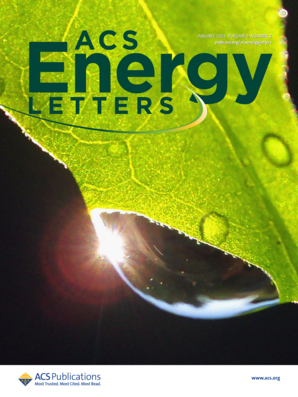Manipulating the Potential Diagram for Better Lithium–Metal Batteries
IF 19.3
1区 材料科学
Q1 CHEMISTRY, PHYSICAL
引用次数: 0
Abstract
Achieving high reversibility in Li-metal batteries, promising candidates for high-energy-density storage systems, remains a major challenge. This study addresses this by optimizing a full-cell potential diagram based on electrolyte energetics. Variations in Coulomb interactions among Li+, anions, and solvents in the electrolyte can affect (1) the electrostatic potential (liquid Madelung potential) of Li+, which can shift both the anode and cathode reaction potentials by the same magnitude; and (2) the operating potential window of the electrolyte, which can cause kinetic hindrance via the formation of a passivation film on the electrode. Systematically balancing these factors based on quantitative experimental results can enhance the performance of the Li-metal battery while minimizing electrolyte degradation at the electrode surface. These insights into the fundamental role of electrolyte energetics in battery design are expected to contribute to the development of comprehensive frameworks for highly stable high-energy-density storage devices.

操纵电位图以获得更好的锂金属电池
实现锂金属电池的高可逆性,作为高能量密度存储系统的有希望的候选者,仍然是一个主要挑战。本研究通过优化基于电解质能量学的全电池电位图来解决这个问题。电解质中Li+、阴离子和溶剂之间的库仑相互作用的变化会影响(1)Li+的静电电位(液体马德隆电位),它可以使阳极和阴极反应电位发生相同幅度的移动;(2)电解质的操作电位窗口,该窗口可通过在电极上形成钝化膜而引起动力学障碍。基于定量实验结果系统地平衡这些因素可以提高锂金属电池的性能,同时最大限度地减少电极表面电解质的降解。这些关于电解质能量学在电池设计中的基本作用的见解有望有助于开发高稳定的高能量密度存储设备的综合框架。
本文章由计算机程序翻译,如有差异,请以英文原文为准。
求助全文
约1分钟内获得全文
求助全文
来源期刊

ACS Energy Letters
Energy-Renewable Energy, Sustainability and the Environment
CiteScore
31.20
自引率
5.00%
发文量
469
审稿时长
1 months
期刊介绍:
ACS Energy Letters is a monthly journal that publishes papers reporting new scientific advances in energy research. The journal focuses on topics that are of interest to scientists working in the fundamental and applied sciences. Rapid publication is a central criterion for acceptance, and the journal is known for its quick publication times, with an average of 4-6 weeks from submission to web publication in As Soon As Publishable format.
ACS Energy Letters is ranked as the number one journal in the Web of Science Electrochemistry category. It also ranks within the top 10 journals for Physical Chemistry, Energy & Fuels, and Nanoscience & Nanotechnology.
The journal offers several types of articles, including Letters, Energy Express, Perspectives, Reviews, Editorials, Viewpoints and Energy Focus. Additionally, authors have the option to submit videos that summarize or support the information presented in a Perspective or Review article, which can be highlighted on the journal's website. ACS Energy Letters is abstracted and indexed in Chemical Abstracts Service/SciFinder, EBSCO-summon, PubMed, Web of Science, Scopus and Portico.
 求助内容:
求助内容: 应助结果提醒方式:
应助结果提醒方式:


